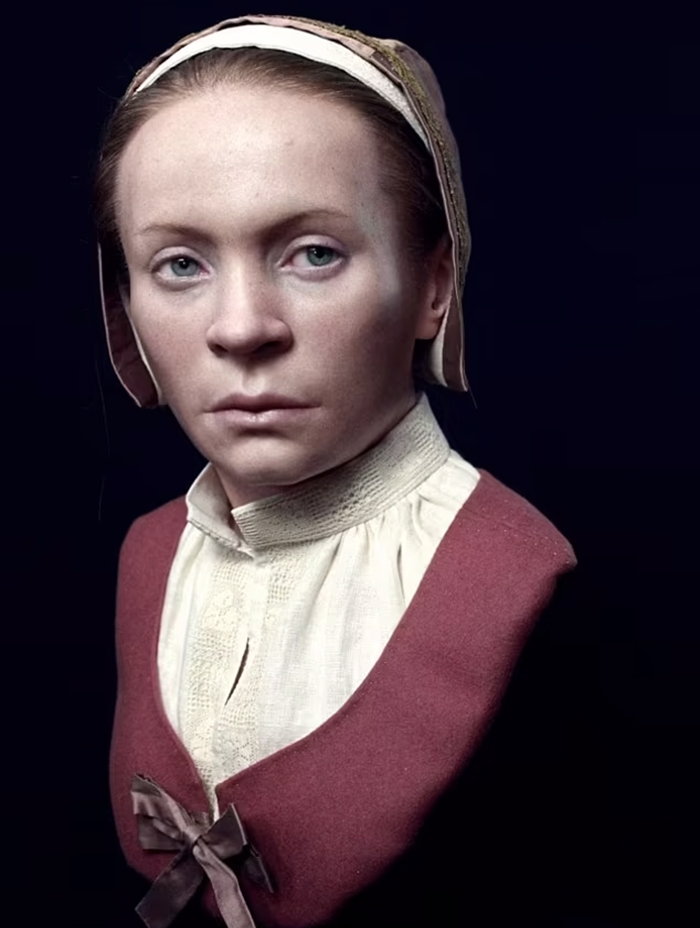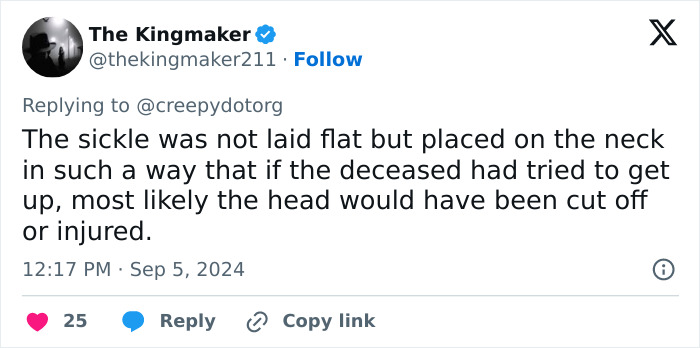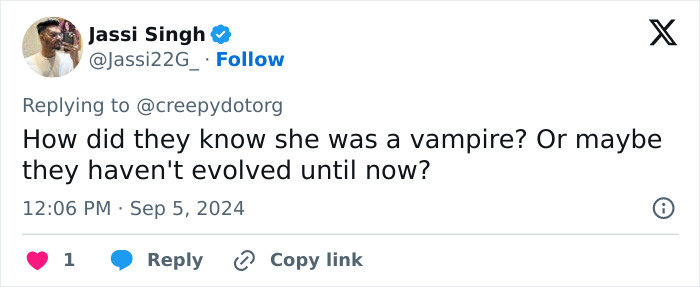
Archaeologists Reveal How A Mysterious “Real-Life Vampire” May Have Spent Her Final Moments
Interview With ExpertJust before the spookiest day of the year, archaeologists have released chilling new information regarding a female “vampire” who died in the mid-17th century.
The woman was unearthed two years ago at a medieval graveyard in Pień, Poland, padlocked inside her grave with a sickle buried across her neck.
Experts now have the general workings to illustrate what she might have looked like, and what may have unfolded during her final moments.
- An 18-year-old 'vampire' was buried with a padlock and sickle in 17th century Poland to prevent resurrection.
- The woman, named Zosia, had a known breastbone deformity and was potentially branded an 'outsider' during the Swedish-Polish wars.
- About 30 out of 100 graves in the 'Field of Vampires' showed signs of restraint, indicating fear of the undead.
A “real-life vampire” was discovered padlocked in her grave, and newly released information details what may have happened
Image credits: Miroslaw Blicharski/Aleksander Poznan
The “vampire,” christened Zosia by experts, was only 18 years old at her time of death, around 350 years ago.
Dubbed by artists, illustrations show the woman as someone who had fair skin, blue eyes, cropped hair, and a single protruding incisor tooth. She was also laid to rest with a silk cap on her head, which meant she was from a family of higher social standing.
But her appearance and status weren’t enough to grant her immunity from the possible accusations thrown her way.
The padlock and sickle placed on her corpse were positioned in a way that suggested villagers were afraid of her coming back from the dead, used as a form of “double protection.”
Professor Dariusz Poliński, who led the research on Zosia with study partner Magda Zagrodzka, told Daily Mail, “It can be assumed that for some reason those burying the woman were afraid that she would rise from the grave. Perhaps they feared she was a vampire.”
Image credits: Nicolaus Copernicus University
He added, “The sickle was not laid flat, but placed on the neck in such a way that if the deceased had tried to get up most likely the head would have been cut off or injured.”
Bone scans have also revealed an abnormality within Zosia’s breastbone, suggesting she may have had a deformity that caused her great pain.
This feature could have further convinced the village to accuse her of evil—before she was brutally sacrificed and buried.
With the Swedish-Polish wars occurring during her time of death, researchers say that Zosia may have been considered Swedish and seen as an “unwanted outsider,” according to the New York Post.
It seems Zosia wasn’t the only person to have been accused of being a vampire at the time
Image credits: Miroslaw Blicharski
The 18-year-old was only one of around 100 skeletons that were found in a field outside the small village of Pień.
Approximately 30 of these graves showed signs of restraint, leading to the site’s infamous nickname “Field of Vampires.”
Poliński said the cemetery was designed for people who had been “excluded from the community,” however, all the graves were left unmarked and there were no written records available about the bodies.
The faces of some corpses were turned down and some were weighed down by stones. A few others had coins placed in their mouths.
“Ways to protect against the return of the dead include cutting off the head or legs, placing the deceased face down to bite into the ground, burning them, and smashing them with a stone,” Poliński explained to Daily Mail.
Image credits: Miroslaw Blicharski
Other graves included a partially exhumed child, a pregnant woman, a woman with advanced stages of syphilis, and a man with a child’s corpse by his feet.
Interestingly enough, however, Zosia was the only one found with a sickle around her neck. With her heavy restraints, experts believe she was most feared by those who killed her.
Daniel Peretti, an associate professor and folklorist at the Memorial University of Newfoundland, told Bored Panda that labeling humans are creatures like “vampires” serve as a coping mechanism after a loved one’s death, allowing people to “have some control” over the uncontrollable.
“Whenever people we love dies, we feel helpless and being able to actually do something helps a lot,” he said.
Commenters added their theories to the growing possibility of what may have happened to Zosia
Image credits: Oscar Nilsson
Some people dove deeper into the lore of vampires, while others blamed the “ignorance” of the past villagers.
“It’s a common enough find across medieval European burial sites. Fear of the ‘undead’ returning was widespread,” someone wrote. “Local lore in Transylvania was very strong around this with the activities of Vlad the Impaler in the 14th century.”
Another theorized, “Sounds like she may have been an outsider who was very badly treated when she met her end and swore revenge so her abusers may have feared that she would return as a revenant to take revenge on them…”
“I’m so sorry for these poor people who were victims of such ignorance,” commented a third. “The one where they described the man with the child at his feet was particularly heartbreaking, people can be so horrible to each other for no reason other than ignorance.”
Fears surrounding the undead and vampires have been circulating for hundreds of years
Image credits: Oscar Nilsson
People have feared the undead ever since the 11th century, as told in Smithsonian Magazine, while vampire myths date back to the late 17th and 18th centuries.
The outlet writes, “A disturbing myth took hold across Eastern Europe: Some people who died would claw their way out of the grave as blood-sucking monsters that terrorized the living.
“Evidence of anti-vampire rituals — a metal rod hammered through a centuries-old skeleton, for instance — is widespread in the region.”
In other parts of Europe, particularly among Slavic people, the belief of these vampires became so widespread it induced mass hysteria and led to brutal executions.
People who died in “untimely ways”—such as suicide—were suspected of vampirism. As a result, their bodies were mutilated to prevent them from rising from the dead and terrorizing the village.
By the 17th century, these “unusual burial practices became common across Poland in response to a reported outbreak of vampires,” said Science Alert.
Image credits: Oscar Nilsson
Legends of these creatures still prevail today, thanks to classics such as Bram Stoker’s Dracula, but as Peretti put it, “there’s no danger anymore, just the thrill.”
“We tell the stories despite knowing they’re not true because we can now look at the vampire [as] something quite different than a monster,” he said. “It’s almost wish fulfillment.”
Additionally, Sabina Magliocco — a professor in the Department of Anthropology at the University of British Columbia — told Bored Panda that vampires have “undergone a revival and reinterpretation” and are now seen as “romantic, misunderstood outsiders.”
“Because they cannot die — they’re already dead — they offer a pleasant fantasy of what it would be like to live forever,” she said. “What’s not to like?”
Poliński and Zagrodzka are planning to return to Pień for more excavations, including one at night with fluorescent lighting that could uncover new bones.
People on social media pointed out the absurdity of the situation
Image credits: unfilteredGray
Image credits: thekingmaker211
Image credits: _PowerOfWord_
Image credits: Jassi22G_
Image credits: Bryne_xx
Image credits: MarkWanless3
Image credits: Doxix93
Image credits: Riptide360
Image credits: easternessence
Image credits: iAyeshamir
12Kviews
Share on FacebookDid this user really write: "She might not actually have been a vampire"???
I literally skipped over the whole article to find this reply. Thank you! Little known fact she may have actually been falsely accused!! Like lmfao
Load More Replies...Nowhere in the article is any reason given for their claim that she was "sacrificed".
If you are in Sweden you can watch this on Vetenskapens Värld. https://www.svtplay.se/video/e4zXAXQ/vampyrernas-gravfalt
Load More Replies...Did this user really write: "She might not actually have been a vampire"???
I literally skipped over the whole article to find this reply. Thank you! Little known fact she may have actually been falsely accused!! Like lmfao
Load More Replies...Nowhere in the article is any reason given for their claim that she was "sacrificed".
If you are in Sweden you can watch this on Vetenskapens Värld. https://www.svtplay.se/video/e4zXAXQ/vampyrernas-gravfalt
Load More Replies...
 Dark Mode
Dark Mode 

 No fees, cancel anytime
No fees, cancel anytime 



































































37
15